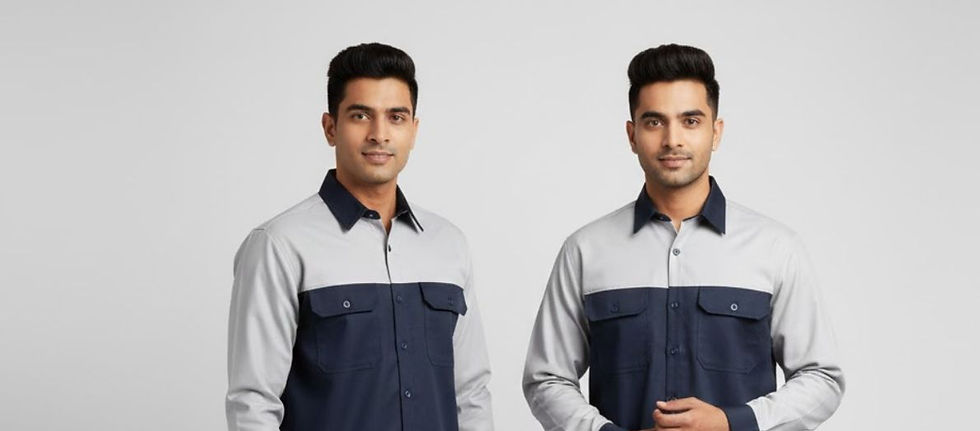Perfect Corporate Office Uniform: A Professional Presence
- MUNI
- Jun 9, 2025
- 4 min read
Updated: Nov 11, 2025
In today's corporate world, an organization's visual identity extends far beyond its logo and website. What employees wear profoundly impacts how a company is perceived, both internally and externally. A well-designed corporate office uniform can be a powerful asset, symbolizing professionalism, fostering unity, and subtly reinforcing brand values. It's about creating a cohesive look that empowers your team and communicates your company's ethos at a glance.
This comprehensive guide will delve into the art and science of designing the perfect corporate office uniform, exploring crucial considerations, key trends in corporate uniform design, and practical steps to ensure your team projects an impeccable professional presence.

The Strategic Value of a Corporate Office Uniform
A thoughtfully designed corporate office uniform offers a multitude of benefits that contribute directly to your business's success:
Enhanced Brand Identity: A unified look creates instant recognition and reinforces your company's distinct image. Your corporate office uniform becomes a tangible extension of your brand presence.
Elevated Professionalism: Uniformity conveys a sense of organization, competence, and reliability, building trust with clients and partners. It sets a high standard for your team's presentation.
Fostered Team Cohesion: When everyone wears the same attire, it cultivates a sense of belonging, equality, and shared purpose among employees, strengthening internal bonds and company culture.
Improved Employee Confidence: Dressing in a sharp, comfortable corporate office uniform can boost an individual's self-assurance, leading to more confident interactions and improved performance.
Streamlined Daily Dressing: Employees no longer face the dilemma of "what to wear," saving time and mental energy, allowing them to focus more on their core tasks.
Key Considerations for Design
Creating an effective corporate office uniform is a nuanced process. Successful corporate uniform design balances aesthetics, practicality, and brand alignment:
Reflect Your Brand's Essence:
Brand Colors & Palette: Integrate your primary and secondary brand colors thoughtfully. Do they dominate, or are they accents?
Company Culture: Is your office environment traditional, modern, innovative, or relaxed? The uniform should align with your company's unique vibe.
Desired Perception: Do you want to convey luxury, approachability, authority, or dynamism? Every design choice contributes to this perception.
Prioritize Comfort and Functionality:
All-Day Wear: Employees spend hours in their uniforms. Fabrics must be breathable, soft, and allow for ease of movement.
Job Role Specifics: Do roles require standing, sitting, presenting, or specific interactions? The uniform should support these activities. For instance, a highly active sales team might need more flexible fabrics than a stationary administrative team.
Temperature & Environment: Consider office air conditioning, seasonal changes, and regional climate. Layering options are often a smart choice.
Fabric Selection & Quality:
Durability: Choose fabrics that can withstand frequent washing and daily wear without pilling, fading, or losing their shape. This ensures longevity and a consistent professional appearance.
Wrinkle Resistance: Fabrics that resist wrinkling are ideal for maintaining a crisp, polished look throughout the day.
Ease of Care: Opt for materials that are easy to clean and require minimal special care, reducing the burden on employees.
Perceived Value: The quality and feel of the fabric directly reflect on your brand's perceived quality.
Fit, Style & Silhouette:
Professional Tailoring: A well-fitted uniform looks sharp and sophisticated. Consider offering options for different body types and providing fitting sessions.
Modern vs. Classic: Decide if your corporate office uniform will feature contemporary cuts and styles or lean towards more traditional, timeless designs.
Versatility: Can individual pieces be mixed and matched (e.g., different shirt/blouse options, blazers with trousers or skirts) to offer variety while maintaining a cohesive look?
Strategic Branding Integration:
Logo Placement: Subtle, well-placed logos (e.g., embroidered on a cuff, collar, or chest) often convey sophistication more effectively than large, overt branding.
Tonal Branding: Using a logo in a slightly different shade of the uniform color can create a chic, understated effect.
Custom Details: Consider branded buttons, zipper pulls, or inner lining patterns for a truly bespoke touch in your corporate uniform design.

Trending Elements in Corporate Office Uniform Design
Modern corporate uniform design is moving towards more comfortable, versatile, and employee-centric solutions:
Smart Casual Elevation: The lines between formal and casual continue to blur. High-quality polo shirts, refined chinos, structured cardigans, and stylish blazers are becoming staples, offering comfort without compromising professionalism.
Performance Fabrics: Inspired by athleisure, uniforms are now incorporating stretch, moisture-wicking, and breathable technologies, making them comfortable for long hours.
Modular & Layered Systems: Collections of interchangeable pieces allow employees to create diverse outfits while maintaining a unified brand look. This also provides adaptability for different seasons.
Subtle Textures & Patterns: Beyond solid colors, subtle textures (e.g., heathered fabrics, fine weaves) or discreet patterns (e.g., pinstripes, subtle checks) can add depth and sophistication.
Emphasis on Inclusivity: Designs are becoming more versatile to suit various body types, genders, and personal preferences, promoting comfort and confidence for all team members.
Designing: A Step-by-Step Approach
Define Your Vision: Collaborate with key stakeholders (HR, Marketing, Leadership) to establish the uniform's objectives, budget, and desired brand image.
Gather Employee Input: Conduct surveys or small focus groups to understand comfort preferences, sizing needs, and practical considerations. This fosters buy-in.
Partner with an Expert: Engage a reputable corporate uniform design specialist or supplier. They can guide you through fabric selection, design options, and branding techniques.
Develop Concepts & Samples: Review design mock-ups and request samples of the actual garments to assess quality, fit, and aesthetic.
Pilot Program (Optional but Recommended): Test the uniforms with a small group of employees to gather real-world feedback before a full rollout.
Implement & Communicate: Clearly articulate the new uniform policy, provide sizing assistance, and ensure a smooth distribution process.
A well-executed corporate office uniform is an investment that pays dividends in brand strength, employee morale, and client perception. By focusing on thoughtful corporate uniform design that aligns with your brand and prioritizes your team's comfort and confidence, you can create a powerful visual statement that sets your company apart.




Comments